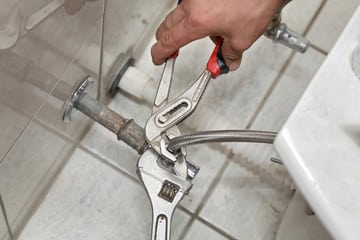Lexington Plumbing offers a wide range of plumbing services, including the installation and repair of faucets, toilets, sinks, showers, water heaters, and sewer lines. They also provide drain cleaning services, plumbing inspections, and emergency plumbing repairs.
Installing a bidet in your bathroom can bring about numerous benefits, including improved hygiene, reduced environmental impact, and increased comfort. While hiring a professional plumber is always an option, many homeowners prefer taking a DIY approach to save time and money. In this comprehensive guide, we will walk you through the process of installing a bidet, providing you with all the information you need to successfully complete the project. From understanding the basics of bidet installation to troubleshooting common issues, we’ve got you covered. So, let’s get started!

Understanding the Basics of Bidet Installation
Before diving into the installation process, it’s important to familiarize yourself with the basics of bidet installation. A bidet is a plumbing fixture that is designed to enhance personal hygiene after using the bathroom. While bidets come in various forms, including stand-alone fixtures and bidet attachments, the installation process remains relatively similar.
Key Components for Installation
To install a bidet, you will need several key components, including backflow preventers, bathroom fixtures, and a water heater. Backflow preventers are essential to prevent water from flowing back into the main water supply, ensuring clean water usage. Bathroom fixtures, such as faucets and showerheads, may also need to be adjusted to accommodate the bidet. Additionally, if your bidet requires hot water, a water heater will be necessary to provide a consistent temperature. For DIY installation tips, you can read FIX COMMON PLUMBING LEXINGTON KY PROBLEMS YOURSELF.
Importance of Following Safety Guidelines
When working with plumbing fixtures, it is crucial to prioritize safety. Following safety guidelines not only protects you from potential accidents but also ensures the longevity of your bidet system. Be sure to wear appropriate protective gear, such as gloves and goggles, when handling plumbing materials. Avoid using chemical degreasers or cleaners that can damage the bidet or cause leaks. If you encounter any water leak during or after the installation, it is important to address it promptly to prevent further damage.
Tools Required for Bidet Installation
To successfully install a bidet, you will need a few essential tools. These tools, which are readily available at most hardware stores, will make the installation process much easier. Here are the tools you will need for bidet installation:
List of Essential Tools
- Wrench: A wrench will be needed to tighten and loosen plumbing connections.
- Screwdriver: A screwdriver is essential for removing and installing screws during the installation process.
- Sealant: Sealants, such as silicone caulk, help create a watertight seal around plumbing fixtures.
How to Use These Tools Efficiently
Using these tools efficiently will ensure a smooth installation process. Familiarize yourself with their functions, and use them according to the manufacturer’s instructions. Using tools correctly will not only save you time but also prevent damage to the bidet or other Lexington plumbing components. If you are uncertain about how to use a specific tool, consider consulting a plumber or watching online tutorials for guidance.
Step-by-Step Guide to Install a Bidet
Now that you have a basic understanding of bidet installation let’s dive into the step-by-step guide. This guide will cover pre-installation setup, the installation process, and post-installation checks to ensure a successful bidet installation.
Pre-Installation Setup
Before beginning the installation, it is important to properly prepare the plumbing and the surrounding area. Here are the steps to follow during the pre-installation setup:
- Shut off the water supply: Locate the water shut-off valve for the bathroom and turn it off.
- Clear the installation area: Remove any obstacles or debris that may hinder the installation process.
- Read the instructions: Thoroughly read the bidet’s installation manual to familiarize yourself with the specific requirements.
- Position the bidet: Determine the desired location for the bidet and mark any necessary mounting points.
- Gather necessary tools and components: Ensure you have all the tools and components needed for the installation before starting.
Installation Process
Once you’ve completed the pre-installation setup, you’re ready to proceed with the installation process. Follow these steps to install your bidet properly:
- Connect the water supply line: Attach the water supply line to the bidet’s inlet valve, ensuring a secure connection.
- Secure the bidet: Use appropriate mounting hardware to secure the bidet to the floor or wall, following the manufacturer’s instructions.
- Adjust bidet settings: Set the bidet’s water pressure, temperature, and other settings according to your preferences.
- Test functionality: Turn on the water supply and test the bidet’s functionality, checking for any leaks or malfunctions.
- Inspect connections: After installation, carefully inspect all connections to ensure they are secure and leak-free.
Post-Installation Checks
After completing the installation, it is important to perform post-installation checks to ensure everything is in proper working order. Here are a few checks to carry out:
- Check for water leaks or drips around connections.
- Ensure all connections are secure and tight.
- Test the bidet’s features, such as water pressure and temperature control.
- Make any necessary adjustments for optimal performance.
- Regularly inspect the bidet for maintenance and upkeep.
Troubleshooting Common Issues During Installation
While bidet installation can be a straightforward process, it’s not uncommon to encounter some challenges along the way. Understanding common issues that may arise and knowing how to troubleshoot them can help ensure a successful installation.
Identifying Potential Problems
Identifying potential problems early on can save you time and effort down the line. Here are some common issues you may encounter during bidet installation:
- Water leaks or drips from connections.
- Inadequate hot water supply, requiring water heater repair or adjustment.
- Issues with bidet settings and controls require troubleshooting and recalibration.
Quick Fixes for Common Installation Issues
Luckily, many common bidet installation issues can be resolved quickly and easily. Consider these quick fixes for common problems:
- Tighten loose connections to prevent water leaks.
- Adjust the water heater temperature settings to ensure an adequate hot water supply.
- Refer to the bidet’s user manual for instructions on recalibrating settings and controls.
Benefits of Installing a Bidet
Installing a bidet offers a wide range of benefits, both in terms of personal hygiene and the environment. Let’s explore some of the advantages of installing a bidet in your bathroom:
Health and Hygiene Benefits
Using a bidet promotes better health and hygiene after using the bathroom. Some specific benefits include:
- Enhanced cleanliness and reduced risk of infections or skin irritations.
- Improved personal hygiene, resulting in better overall health.
- Gentle and soothing cleaning experience, providing a sense of comfort and freshness.
Environmental Advantages
In addition to the health benefits, bidets offer environmental advantages, including:
- Reduced paper waste, contributing to sustainable bathroom practices.
- Minimized ecological impact associated with toilet paper production and disposal.
- Water savings, as bidets use less water compared to traditional toilet paper usage.
Can I Use My Existing Plumbing for Bidet Installation?
Many homeowners wonder if their existing Lexington plumbing can support bidet installation. The answer depends on several factors.
When it comes to bidet installation, compatibility with your existing plumbing is crucial. Existing Lexington plumbing must have access to water supply lines and suitable connections to accommodate the bidet’s inlet and outlet valves. In some cases, additional Lexington plumbing modifications may be necessary, such as installing backflow preventers or water pressure regulators.
Determining compatibility is best done by consulting a professional plumber, who can assess your plumbing system and provide expert guidance. They will consider factors such as water pressure, pipe size, and overall plumbing layout to determine the feasibility of bidet installation using existing plumbing.
If your existing plumbing is not compatible, a plumber can recommend alternative solutions, such as installing new plumbing lines or utilizing alternative bidet options that don’t require significant plumbing modifications.
Conclusion
In conclusion, installing a bidet not only enhances your bathroom experience but also promotes better hygiene and environmental sustainability. By following the step-by-step guide and using the right tools, you can easily install a bidet in your home. Remember to prioritize safety and consult a professional if needed. Enjoy the health benefits of improved hygiene and reduce your carbon footprint with this simple DIY project. If you have any further questions or need assistance, check out our frequently asked questions section for more information. Happy bidet installation!
Upgrade your bathroom with ease using Hubbard Mechanical’s DIY guide to installing a bidet in Lexington. Empower yourself with step-by-step instructions and expert tips for a successful bidet installation. Transform your bathroom experience and enjoy the convenience of a bidet by starting your project today!
Frequently Asked Question
Can you install a bidet on any toilet?
Bidets can typically be installed on most standard toilets. Various types include electric, non-electric, and handheld bidet sprayers. Installation may need basic plumbing skills or a professional plumber’s assistance. Verify bidet-toilet compatibility before installing.


Recent Comments